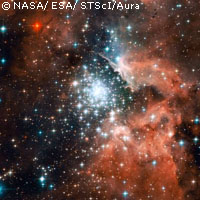Jupiter, Saturn or near-Earth space - where next for Europe in space?
A clearer idea of Europe's next destinations in space emerged at a meeting of the European Space Agency (ESA) Space Science Advisory Committee on 17 and 18 October. A number of candidates for future missions were selected, including the study of the Jovian System, Saturn's satellites and dark matter. 'It has been an arduous process both inside ESA and in the community to get these winning groups into what I suppose can be said to be the quarter-finals of one of the ultimate competitions in world space science,' said ESA's Director of Science, David Southwood. 'We can now get glimpses of the future and it is going to be exciting!' From a list of 50 proposals submitted by the scientific community, the candidates making it to the next phase of selection are: - Laplace - study of the Jovian system The Jovian System is a small planetary system in its own right. The proposed mission would investigate the habitability of the Jovian system, using three orbiting platforms for observations. - Tandem - a new mission to Saturn, Titan and Enceladus The idea is to explore the two Saturn moons both in-situ and from orbit. The mission would investigate the Titan Enceladus systems, their origins, interiors, evolution and astrobiological potential. A discussion on which of the above to target is likely to take place with international partners in the coming years. - Cross-scale - a study of near-Earth space Within this mission, 12 spacecraft would make simultaneous measurements of plasma (the gas of charged particles surrounding Earth) on different scales and in different regions in near-Earth space. If approved, the mission would be implemented in collaboration with the Japanese Space and Exploration Agency (JAXA). - Marco Polo - an asteroid sample-return mission Marco Polo would characterise a near-Earth object at multiple scales and return a sample. This could provide new information on the evolution of the Solar System, the role of minor bodies in the process, the origins and evolution of Earth and of life itself. This mission would also be implemented in collaboration with JAXA. - Dark energy Two proposals on investigating dark matter and dark energy were submitted. Although different techniques are proposed (a wide-field imager versus a near-Infrared all-sky surveyor), they address the same basic science goal. - Plato - a new planet-finder A photometry mission to detect and characterise transiting exoplanets, Plato would also measure the seismic oscillations of their parent stars. - Spica - a next-generation infrared observatory This project would lead to a medium- and far-infrared observatory with a large-aperture cryogenic telescope. The mission would study planetary formation, the way in which the solar system works and the origin of the universe. The mission would be a joint project with JAXA. - XEUS - a next-generation X-ray space observatory XEUS would study the fundamental laws of the universe, as well as its origins. Key focus areas would be: the growth of supermassive black holes, cosmic feedback and galaxy evolution, evolution of large-scale structures, extreme gravity and matter under extreme conditions. Various international partners have expressed an interest in participating in XEUS. All of the above missions will now compete in an assessment cycle, due to end in 2011. This will result in the selection of two missions for implementation, with launches in 2017 and 2018. 'We believe that the set of selected missions will shape the future of European space science,' said Tilman Spohn, chair of ESA's Space Science Advisory Committee.



